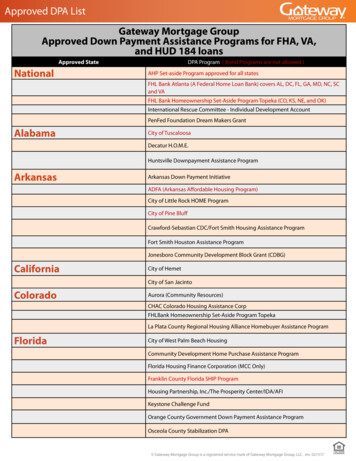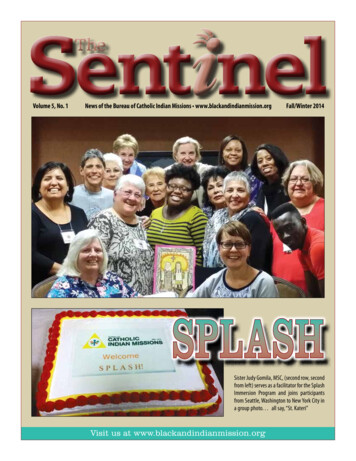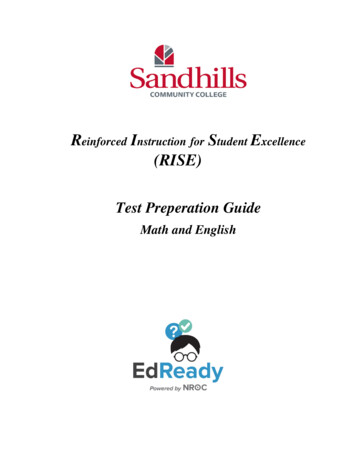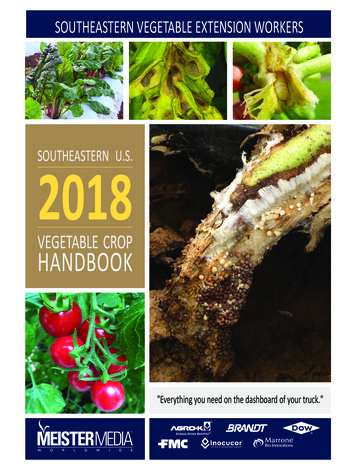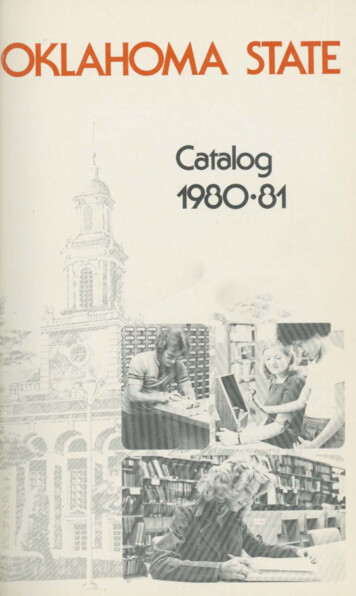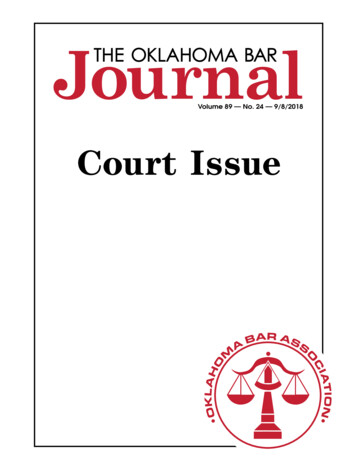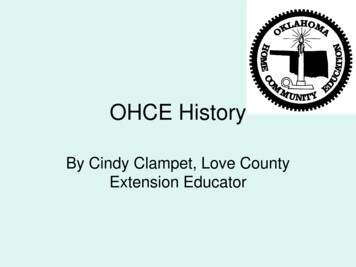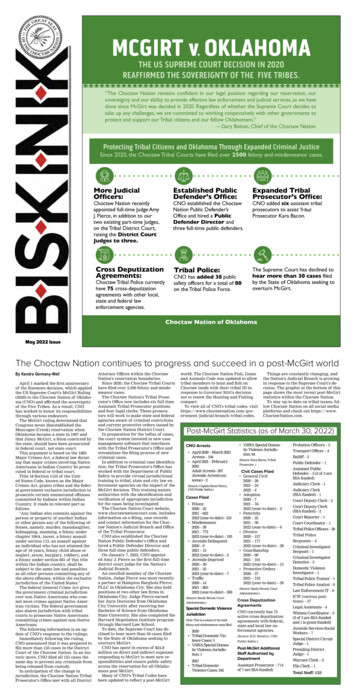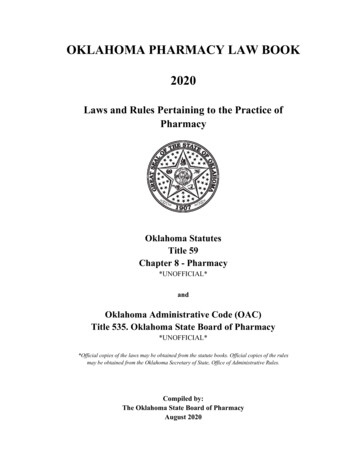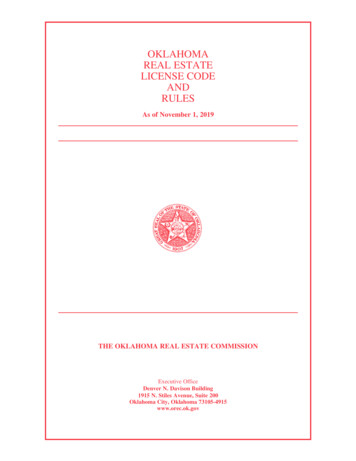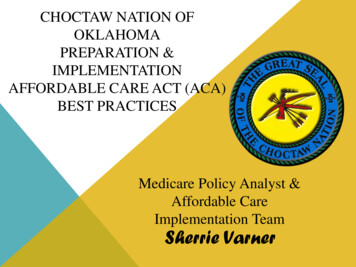
Transcription
CHOCTAW NATION OFOKLAHOMAPREPARATION &IMPLEMENTATIONAFFORDABLE CARE ACT (ACA)BEST PRACTICESMedicare Policy Analyst &Affordable CareImplementation TeamSherrie Varner
OBJECTIVESBest Practices:Challenges: Staffing. Patients. Contract negotiations. The Unknown Establish an ACA “team”.Steps to prepare and beginimplementation.Focus on internal processes toidentify potential weaknesses.Focus on accurate data gathered atthe point of Registration.Internal staff education.Tribal member/patient outreachand Education.
BEST PRACTICES
ESTABLISH AN AFFORDABLE CAREACTTEAM “Key” staff was selected to be a part of the ACA workgroup / team. Staff knowledgeable in Medicare, Medicaid, private insurance, front deskRegistration procedures, Business Office and management were recruited. Goals were set to become educated on the Affordable Care and how thesechanges would effect the internal processes and the tribal members.o The benefits and the negative side of the law was discussed to better understand what wewould be facing. (Additional Medicare preventive benefits, reduction of the Part D “donuthole”, un-insured patients would now be eligible for insurance coverage PLUS the healthtax penalty some patients might face if they remained un-insured.) Continuous meetings by the team members to work towards implementationas well as learn from each other. This team provides internal staff updates/education as well as outreach andeducation to the tribal members.
STEPS TO PREPARE AND BEGINIMPLEMENTATION Registered for any face-to-face training sessions and/or on-line Webinar classes tobegin learning about the Affordable Care Act and how it will effect Indian Country. Met with internal departments to identify established methods of tribal membercontact in an effort to reach out to tribal members and get the word out about thechanges.oooIndian Education – include educational handouts in school supplies.Daycares/HeadStart – include educational handouts to Choctaw children.Choctaw Bisknik Newsletter – included educational articles to tribal members. Utilized National educational information plus information gathered from training toinclude in the outreach handouts and newsletter articles. Updated our Web sites to include information about, what is the Affordable Care Actand what steps to take to ensure they make an educated decision come January 2014. Social Media- Included educational messages on the Choctaw Nation FaceBook pagealong with “Did You Know” messages in employee emails to keep the messagemoving.
FOCUS ON “INTERNAL”PROCESSES The “team” prepared a list of internal processes that needed to be evaluatedto ensure we would be able to transition without great difficulty.o Registration: capturing CDIB, tribal membership, SSN, contact information, etc.o Benefit Coordinators: length of time spent during day assisting patient’s with insuranceneeds.o Scanning: Making sure to scan all documents into the system as well as verify ifdocuments on file are current. On-site visits were made to each clinic/registration area to observeRegistration staff as well as the patient’s interaction with the requiredprocesses.o Did Registration staff understand “why they asked for current insurance cards, CDIB,tribal membership cards, etc.?o Were they able to obtain the needed information when the patient checked in for thevisit?
FOCUS ON “INTERNAL” PROCESSES(CONT.) Meeting was held with clinic/department management to discuss on-sitevisit findings.o Weaknesses.o Best Practices. Action given to each manager to reduce the weaknesses and providetheir plan of action with 30-day deadline to implement.o Staffing issues.o Staff education.o Equipment issues.
FOCUS ON ACCURATE DATA GATHERED ATREGISTRATION Based on our on-site visits across the board the Registration staff did a very good job ofgetting the patients checked in and registered and off to their scheduled appointments in atimely manner. We did realize that we have many different Registration locations and every site does theprocesses differently to accomplish the same end result so “blanket” staff training wouldnot be as easy as we thought. Staff training was set up to go over Medicaid, Medicare and private insurance guidelinesas it applies to Registration processes and Business Office needs to submit a clean, timelyclaim for reimbursement. SharePoint already existed on our internal Intranet site so we added a page just forRegistration staff.o Consent forms, New patient info sheets, etc. are all in one common location.o Educational materials were added. (Medicaid income guidelines, Medicare quick tips,Affordable Care Act updates/changes etc.)
REGISTRATION STAFF AND INTERNALPROCESSES SharePoint, on our internal Intranet site now has the designated section forRegistration Staff. This site houses Hot Topics, Updates and Changes, Forms and Medicare,Medicaid and private insurance and now Affordable Care Act resources. The staff gets an email alert that something has been updated and the link tothe intranet site. This allows all the staff to have immediate updates andaccess to the most current educational documents.o The resources located on the intranet are used in the internal training classes forRegistration staff. Existing and new hire staffs receive the same message in an effort tokeep the internal processes consistent.
INTERNAL STAFF EDUCATION Focus was put on front desk registration staff to properly perform patientscreening on every type of patient that checks in.Emphasis on getting copies of the insurance cards, patient identification,CDIB cards, tribal membership cards, correct “legal” name and addresses soclaims can be filed correctly and timely.Internal training classes scheduled with consideration of staffing so that allstaff hears the same message with respect to Medicare, Medicaid and otherinsurance program guidelines and internal processes.Business Office staff was invited to attend to reinforce the message. TheBusiness Office can only be successful if the Front Desk Registration staffobtains accurate and up-to-date patient and insurance information.Medicare claims data indicated that more than 50% of the claim errors couldhave been prevented at Registration.o Examples: Name and Medicare number mismatch.Patient not eligible/entitled on this date of service.Cannot identify this patient as our insured.Claim filed to wrong payer/contractor.
INTERNAL STAFF EDUCATION(CONT.) Employee health fairs provided an opportunity to pass out Affordable CareAct handouts and short presentations were given about the changesincluding the new health-tax penalty for all that remain un-insured as ofJanuary 2014. “Did you know” emails continue to be sent out reminding staff of theupcoming changes AND to not delay, get their families CDIB and tribalmembership cards to protect their Native American ancestry as well as a“safety net” for 2014 in the event someone in the family will be un-insured. Further internal staff training will be provided as it gets closer. The depthof the training will depend on the amount of patient interaction buteveryone will hear the message.o ChocTalks is a monthly educational internal staff meeting that all staff is required tohear and/or sign off on. This is how we share upcoming events, special dates, newpolicies and/or new procedures. ACA has been included in these monthly staffingupdates.
INTERNAL STAFF EDUCATION(CONT.) Partnership with Oklahoma Health Care Authority (Medicaid) to comeon-site and provide training for staff on updates/changes. Email alerts to staff letting them know of updates/changes and anyinternal issues to keep staff immediately up-to-date. Intranet section for patient registration and Benefit Coordinator staff.The site houses updates, hot topics and training resources. Internally developed posters to help with awareness. Value ofInsurance, Tribal Membership Enrollment, etc.
PATIENT EDUCATION Ongoing education to tribal members during the Medicare open enrollment(October-December) is provided at each of the Choctaw Nation CommunityCenters. Medicare, Medicaid along with Affordable Care information is presented. A bag with CMS educational materials along with a small give-away was providedat each of the Community Center presentation locations. A power pointpresentation was used as a visual, especially when discussing dates, premiumamounts and deductibles and even examples of the new health-tax penalty. After each presentation we remained at the Center to answer any question that themembers might have. Pharmacy staff also traveled along and provided handouts to consolidate all of theirmedications in an effort to help those considering enrolling in Medicare Part D.Community Health Nurses traveled also providing flu shots and blood pressure checks.Advertising was done in the Choctaw Bisknik and fliers at the Community Centersaheadof time in an effort to “draw a crowd” to hear the educational presentations.
PATIENT EDUCATION (CONT.) Senior Expo- Annual Senior Health Fair, set up booth and visitedwith each Senior about Medicare, Medicaid and Affordable CareAct. Handouts provided for each.Each Labor Day Choctaw Nation has a four-day festival whichincludes free concerts, carnival/midway, healthy-living tent withbooths, 5K run, arts/crafts, stickball/volleyball/softball/fastpitch/horseshoe tournaments, gourd dancing and MUCH MUCHmore.oPresentations will be given during the weekend to discuss, HowHealthcare Reform Will Affect You and Your Family along withWhat You Should Know About Medicare and Medicaid.oA booth in the healthy living tent will also be manned throughout theweekend to answer any questions regarding the Affordable Care Act.
PATIENT EDUCATION (CONT.)Promoting Medicaid/”free” Health Insurance Printed educational brochures given out to patients regarding the differencebetween Native American health benefits versus Insurance coverage.o Internal brochures available.o Oklahoma Health Care Authority education materials available.(coloring books/crayons, SoonerRide, benefit handouts) Benefits of “free” health coverage.o Income to the tribe for services rendered.o Comfort in knowing Medicaid benefits allow flexibility to be seen at any health carefacility that accepts Oklahoma Medicaid.o Speeds up the process in the event the patient needs outside medical care throughChoctaw Referred Care.
PATIENT EDUCATION (CONT.)Patient Incentives: Tribal Medicaid Administrative Match (T-MAM).Oklahoma is the first state to receive a payment for“product”. This payment is based on approved newenrollment as well as approved re-certifications. With the additional T-MAM reimbursement, patientincentives will be purchased. The giveaways will be forchildren and/or pregnant women that qualify forSoonerCare.
PATIENT EDUCATION (CONT.)Education: Families With Children: Focus on obtaining tribalmembership and CDIB cards forchildren. Distributed handouts through:o The Indian Education department.School supplies distributed at theschools.o Through JOM, a summer youth workprogram for kids 13-18.o WIC offices.
CHALLENGES
STAFFING Staff training .it will be last minute at best!Increase workload due to the additional amount of time spent with eachpatient; educating, explaining, exploring coverage/costs and enrollment.Staff level of understanding the importance of insurance coverageversus Native American health care benefit. “Why does the patient/Ineed insurance when they/I have free health benefits?”Staff level of understanding. Can they take on these extra duties? Canthey become “insurance counselors and “sell” a Marketplace plan?Scheduling issues, patient arrival times often limit the amount of timespent with patients to fully educate and screen for eligibility. When willbe the “right time” to sit down with the patient? Will they come backafter their appointment?Registration staff needs to be proactive in getting uninsured patients toBenefit Coordinator staff for one-on-one assistance. Will this happen onevery un-insured patient?
PATIENTS Trust. “Why are we being made to buy insurance for our families?”“What about the Treaty Agreement and my entitlement to healthcare benefits?” Costs. “Why should I pay for insurance when I can be seen here forno charge?” “I can’t afford it? I make too much to qualify forMedicaid but don’t make enough to pay for health insurance.” “Nowe don’t want it!” Patient’s level of understanding insurance benefits. Havinginsurance coverage may be a “first” for many patients.Understanding and keeping up with the monthly premiumpayments will be a challenge. Patient’s do not understand the difference between the NativeAmerican benefit and insurance coverage.
PATIENTS (CONT.) Providing needed information. Not all patients carry theirCDIB, tribal membership PLUS their last year’s tax returnwhen they come for an appointment. Minor children maynot have tribal membership since they can be seen undertheir parents. Willingness to share information. Not every patient isforthcoming with their personal information. Especially ifthe government is involved. What if the patient does not file taxes? What about the IRS health-tax penalties? What if we signthem up for a Marketplace plan based on current incomeand at tax time their income changed and they owe taxes?Who is to blame?
PATIENTS (CONT.) Patient not understanding the law changes and how it will effectthem. “I don’t have insurance. The only insurance I have is whatthe law requires and that’s on my car.” Patient education. How do we reach everyone? What about the tribal members that our outside of our 10 ½counties? (other states?) Patients that don’t want Medicaid benefits and they are free.Patient’s comments include: “I didn’t have “welfare” with my first child and I don’t need it with this one”.“I don’t qualify, I/we make too much money”.“I have a CDIB, I don’t need insurance”.“I’m running late, I don’t have time, I’ll do it the next time”.“I don’t want the Government in my business”.“I’m Choctaw, I don’t need any other insurance”.
QUESTIONSAssistant Chief Gary BattonChief Greg Pyleand
THANK YOUFORATTENDINGCHOCTAW NATION OFOKLAHOMAPREPARATION &IMPLEMENTATIONAFFORDABLE CARE ACT (ACA)BEST PRACTICES
Best Practices: Establish an ACA "team". Steps to prepare and begin implementation. Focus on internal processes to identify potential weaknesses. Focus on accurate data gathered at the point of Registration. Internal staff education. Tribal member/patient o. utreach and Education.
